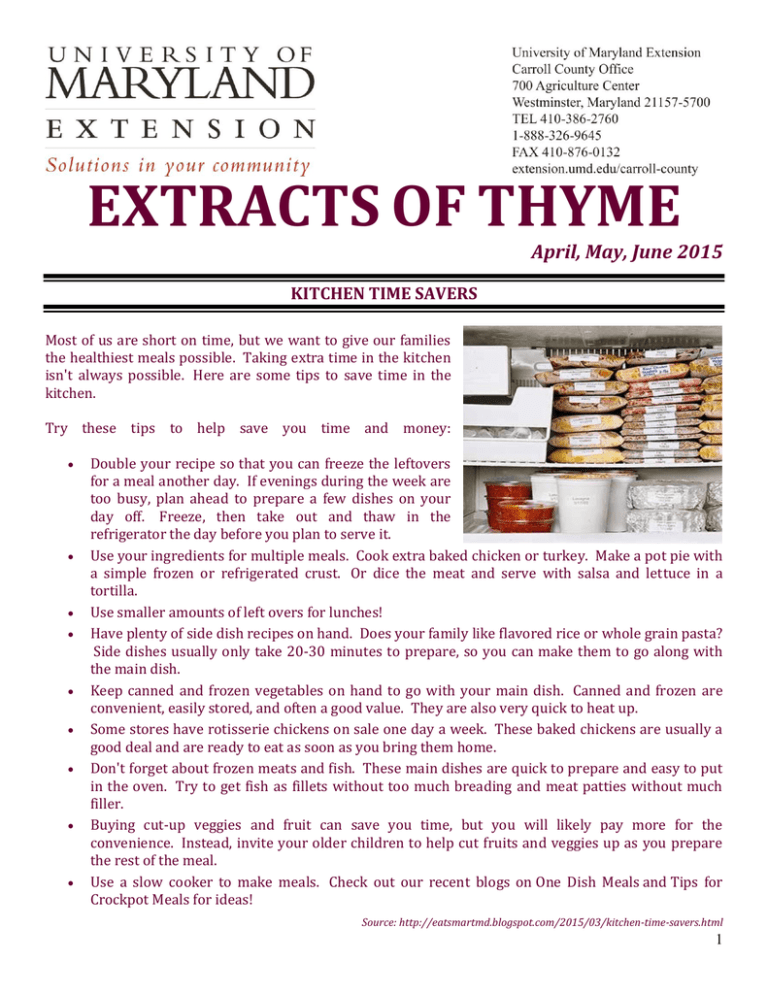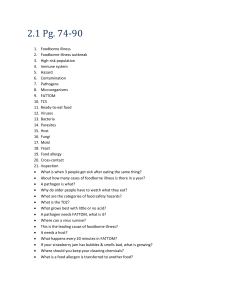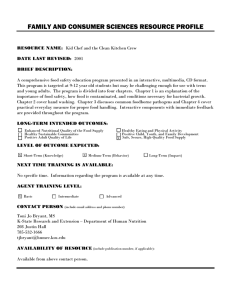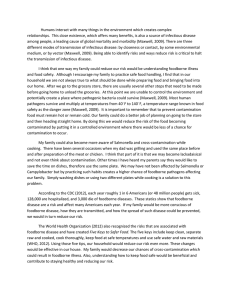EXTRACTS OF THYME
advertisement

EXTRACTS OF THYME April, May, June 2015 KITCHEN TIME SAVERS Most of us are short on time, but we want to give our families the healthiest meals possible. Taking extra time in the kitchen isn't always possible. Here are some tips to save time in the kitchen. Try these tips to help save you time and money: Double your recipe so that you can freeze the leftovers for a meal another day. If evenings during the week are too busy, plan ahead to prepare a few dishes on your day off. Freeze, then take out and thaw in the refrigerator the day before you plan to serve it. Use your ingredients for multiple meals. Cook extra baked chicken or turkey. Make a pot pie with a simple frozen or refrigerated crust. Or dice the meat and serve with salsa and lettuce in a tortilla. Use smaller amounts of left overs for lunches! Have plenty of side dish recipes on hand. Does your family like flavored rice or whole grain pasta? Side dishes usually only take 20-30 minutes to prepare, so you can make them to go along with the main dish. Keep canned and frozen vegetables on hand to go with your main dish. Canned and frozen are convenient, easily stored, and often a good value. They are also very quick to heat up. Some stores have rotisserie chickens on sale one day a week. These baked chickens are usually a good deal and are ready to eat as soon as you bring them home. Don't forget about frozen meats and fish. These main dishes are quick to prepare and easy to put in the oven. Try to get fish as fillets without too much breading and meat patties without much filler. Buying cut-up veggies and fruit can save you time, but you will likely pay more for the convenience. Instead, invite your older children to help cut fruits and veggies up as you prepare the rest of the meal. Use a slow cooker to make meals. Check out our recent blogs on One Dish Meals and Tips for Crockpot Meals for ideas! Source: http://eatsmartmd.blogspot.com/2015/03/kitchen-time-savers.html 1 ONE-DISH MEALS: COOK AND CLEAN-UP IN A SNAP! Prepare healthy, home-cooked meals using just one pot or pan. Clean-up will be quick and easy and you might even have leftovers for lunch the next day! Kitchen tools like crock pots and electric skillets are not very costly and are perfect for making a variety of healthy meals all in one dish. Here are some tips for cooking one-pot dishes: Crock Pot or Slow Cooker: Roast a chicken with diced vegetables like carrots, celery, squash, onion and fresh or dried herbs. Use leftover chicken for sandwiches, salads, and make soup stock with the chicken bones. Cook up a pot of chili with canned tomatoes, canned beans, canned corn, and lean ground turkey or beef. Add spices like chili powder, cumin, and garlic powder. Serve with a green salad and whole grain cornbread. Stir up some vegetable soup using canned tomatoes, frozen or canned mixed vegetables, canned beans, chopped onion, garlic, and water or vegetable stock. Add fresh or dried herbs like basil, parsley, or Italian seasoning. Electric Skillet: Make breakfast foods like whole wheat pancakes or breakfast fajitas with sauteed vegetables like peppers, tomatoes, red onions, and scrambled eggs wrapped in whole-grain tortillas. Cook beef macaroni and cheese whole grain pasta, canned tomatoes, low-fat cheese, lean ground beef, and Italian seasoning. Serve with steamed vegetables or a salad to complete your meals. Try our recipe! MAY IS MENTAL HEALTH MONTH! This year, the theme is “Mental Health Matters: In your life” to remind people that taking care of mental health is just as important as physical health. So why is good mental health important? Good mental health is essential to overall health and personal well-being. It also contributes to the ability to lead a healthy, balanced, and productive life. Emotional problems can impair a person's thinking, feelings, and behavior and, over time, can become increasingly serious and disabling. Unfortunately, many people do not seek treatment for mental health issues for a number of reasons. They may not be completely aware of the extent of their problem, they may be hesitant to make contact with a mental health professional because they fear they will be stigmatized, or they may not know how to access services. Yet, overall quality of life is greatly improved when a person with a mental health concern or problem seeks help and receives appropriate treatment from a qualified professional. What are some easy ways to begin increasing your mental health? 2 1. Assess the strength of your needs while learning to obtain the proper amounts for happiness. We all have five basic human needs — connection, freedom, significance, survival and enjoyment. While we share that in common, the strength of our needs vary. The key to happiness is to engage in behavior that brings you the precise amount of each need you want. Having too little leaves you feeling deprived and having too much can leave you feeling oversaturated. 2. Understand and take responsibility for your choices. You have choices in every situation. You may not have any "good" choices or choices you like, but there are choices nonetheless. You are doing whatever you're doing because you chose it, not because someone forced you. You may be doing it to keep your job, please a loved one or to save your life ... but you are choosing it. When you let go of the victim mentality and embrace the choice aspect of all you do, you will feel empowered. 3. Make the connection between your behavior and your progress or lack thereof. We often look to outside "causes" for our success — or lack thereof — and forget to look at what we, ourselves, are doing or not doing to move us toward our goals. When you begin to take charge of your own outcomes instead of giving that power to others, you will feel much happier. 4. Understand the power of your perception and how to change it. We often make up stories about people and events in our lives that have nothing to do with the facts of the situation. They are simply our interpretation. Your interpretation can cause you great unnecessary turmoil. If your perception isn't serving you, change it! Make up a better, happier, more generous story. 5. Find the balance in all things. Everything that happens to you has equal positive and negative qualities; a ying and a yang, pros and cons. The problem is our perception again. We tend to label things as good or bad, positive or negative, painful or pleasurable. The truth is, both sides are always present. It just depends on where you place your focus. Seeing both sides equally will improve your mental health. 6. Distinguish and choose between what feels good right now and what will feel even better later. We often engage in a battle of what we want right now versus what we really want. As a general rule, those who can delay gratification achieve greater satisfaction than those who always indulge themselves in the moment. But there is another option. 7. Expanding either/or thinking to a both/and approach. In our Western culture, we often tell ourselves that we must choose between two options. But I say, "Why not have both?" Now, I do realize sometimes there really is a dilemma and a person must choose, but those times occur less frequently than you think if you begin to ask yourself, "How can I have/do/be both?" 8. Uncover your self-sabotage, while learning to minimize its hold on you. We all have some negative thoughts about ourselves that were installed in our psyche before we were old enough to distinguish fact from fiction. The fact that these negative thoughts most often came from those you trusted made it even harder to dispute. However, if you want to succeed at your goals, then you must bring your self-sabotage out from the dark of the subconscious to the light of day where you can examine its veracity. If you determine it simply isn't true (and it usually isn't), then you can let it go. Don't attempt to "do battle" with the ideas, as this gives them more importance than they deserve. 9. Accept others exactly as they are. They aren't likely to change — or at least not because you want them to — so you are only frustrating yourself with the effort. Know that everyone has one life to live in this go around and gets the option to spend it however they choose. If you don't like the way a particular person is choosing to live his or her life, then limit your involvement with that person. Stop trying to get people to change to fit who you want them to be. 10. Move toward your goals at a pace that is challenging, yet doable, for you. When you set goals that are too easy, you can become bored. But on the other hand, if you make it too difficult, you may give up. Finding the right pace for you is essential to your success Source: www.yourtango.com 3 WHO REGULATES FOOD SAFETY IN AMERICA, AND WHY IS APRIL 7TH 2015 IMPORTANT? This article was modified from Henley, S. (2014). “Don’t Wash Your Chicken!” Results of an Interdisciplinary Approach to Reduce Incidence of Infectious Foodborne Diseases. (Doctoral dissertation).1 This year the World Health Organization (WHO) is celebrating World Health Day on April 7th 2015, to highlight the importance of food safety.2 The focus of this article is to provide some background of how the U.S. government monitors and defines food safety issues. How Foodborne Illness is Acquired The World Health Organization defines foodborne illness as a disease that is either infectious or toxic in nature, and occurs through the ingestion of contaminated food.3 Chemical, Virus, and Bacterial In the US foodborne illness is estimated to cause 9.4 million domestically acquired episodes of foodborne illnesses each year, due to 31 major pathogens.4 The economic burden of foodborne illness is estimated to be $77.7 billion dollars, which is spent towards health related costs and loss of productivity. 5 Vulnerable Populations Certain populations are more susceptible than others to foodborne illness. Vulnerable populations include children 5 years and younger, pregnant women, the immunosuppressed (e.g. persons living with AIDS or cancer), and adults 50 years and older.6-12 These populations are more vulnerable because a lower infectious dose is needed to cause illness compared to healthy individuals. How Foodborne Illness and a Foodborne Outbreak are Defined Foodborne illness can sporadically strike an individual or occur as an outbreak. Foodborne outbreaks are defined when two or more individuals encounter the same symptoms after ingesting a common food.13 Outbreaks can affect thousands of people in multiple states.14 FoodNet: Foodborne Diseases Active Surveillance Network The ability to determine a foodborne outbreak’s cause and population most affected is accomplished by active monitoring from The Foodborne Diseases Active Surveillance Network, also known as FoodNet. Established in July 1995, FoodNet continues to actively monitor and record the magnitude of both sporadic cases of foodborne illness and outbreaks.15 FoodNet is a collaborative effort between the Center for Disease Control and Prevention (CDC), the U.S. Department of Agriculture’s Food Safety Inspection Service (USDA-FSIS), and the Food and Drug Administration (FDA).15 FoodNet communicates with clinical laboratories in 10 states (Connecticut, Georgia, Maryland, Minnesota, New Mexico, Oregon, Tennessee, California, Colorado, and New York), and selected counties, in order for its surveillance to represent 15% of the US population.15 Though the initial intentions of FoodNet were never to equally represent all racial and ethnic populations, it has improved its demographic representation, yet Hispanics remain under represented.16,17 4 FoodNet is an invaluable program to help identify rates of sporadic foodborne illness as well as outbreaks in America.17 Outbreak surveillance helps to identify 1) foods involved, 2) the settings of where contaminated food(s) were consumed, 3) where contamination occurred in the farm to fork continuum, and 4) trends of the outbreak (e.g. demographics, season).18 FoodNet offers timely and accurate information that has resulted in a reduction in the incidence and outbreaks of several infections of foodborne pathogens over time.18,19 Prior to FoodNet America had no way of estimating the impact of foodborne outbreaks,19 and it remains an important resource to monitor and improve America’s food safety system from farm-to-fork. Reporting a Foodborne Illness in Maryland Contact your local health department. Resources 1. Henley, S. (2014). “Don’t Wash Your Chicken!” Results of an Interdisciplinary Approach to Reduce Incidence of Infectious Foodborne Diseases.(Doctoral dissertation) Retrieved from Drexel University. Philadelphia, Pennsylvania: ProQuest/UMI, 2013 (Publication No. 3608259). 2. http://www.who.int/campaigns/world-health-day/2015/event/en/ 3. Anonymous. 2007. World Health Organization Fact Sheet N 237 Food safety and foodborne illness. Available at: http://www.who.int/mediacentre/factsheets/fs237/en/. Accessed July 14, 2010. 4. Scallan, E., P. M. Griffin, F. J. Angulo, R. V. Tauxe, and R. M. Hoekstra. Foodborne illness acquired in the United States--unspecified agents. Emerg Infect Dis. 17:16-22. 5. Scharff, R. L. 2012. Economic Burden from Health Losses Due to Foodborne Illness in the United States. J. Food Prot. 75:123-131. 6. Byrd-Bredbenner, C. 2004. Food Preparation Knowledge and Attitudes of Young Adults. Top Clinical Nutrition. 19:10. 7. Fischer, A. R., A. E. de Jong, R. de Jonge, L. J. Frewer, and M. J. Nauta. 2005. Improving food safety in the domestic environment: the need for a transdisciplinary approach. Risk Anal. 25:503-17. 8. Koehler, K. M., T. Lasky, S. B. Fein, S. M. Delong, M. A. Hawkins, T. Rabatsky-Ehr, S. M. Ray, B. Shiferaw, E. Swanson, and D. J. Vugia. 2006. Population-based incidence of infection with selected bacterial enteric pathogens in children younger than five years of age, 1996-1998. Pediatr Infect Dis J. 25:129-34. 9. Kruszyna, T., M. Walsh, K. Peltekian, and M. Molinari. 2008. Early invasive Listeria monocytogenes infection after orthotopic liver transplantation: case report and review of the literature. Liver Transpl. 14:88-91. 10. Scallan, E., B. E. Mahon, R. M. Hoekstra, and P. M. Griffin. 2011. Estimates of Illnesses, Hospitalizations, and Deaths Caused By Major Bacterial Enteric Pathogens in Young Children in the United States. The Pediatric Infectious Disease Journal. 32:217-221. 11. Taylor, J., E. Galanis, L. Wilcott, L. Hoang, J. Stone, J. Ekkert, D. Quibell, M. Huddleston, R. McCormick, and Y. Whitfield. 2012. An Outbreak of Salmonella Chester Infection in Canada: Rare Serotype, Uncommon Exposure, and Unusual Population Demographic Facilitate Rapid Identification of Food Vehicle. J. Food Prot. 75:738-742. 12. Voetsch, A., F. J. Angulo, T. F. Jones, M. R. Moore, C. Nadon, P. McCarthy, B. Shiferaw. M. B. Megginson, S. Hurd, B. J. Anderson, A. Cronquist, D. J. Vugia, C. Medus, S. Segler, L. M. Graves, R. M. Hoekstra, and P. M. Griffin. 2007. Reduction in the Incidence of Invasive Listeriosis in Foodborne Disease Active Surveillnace Network Sites, 1996-2003. Clinical Infectious Diseases. 44:513-520. 13. Anonymous. Date, 2000, Appendix B Guidelines for Confirmation of Foodborne-Disease Outbreaks. Available at: http://www.cdc.gov/mmwr/preview/mmwrhtml/ss4901a3.htm. Accessed July 2013. 14. Anonymous. 2008. Outbreak of Salmonella Serotype Saintpaul Infections 147 Associated with Multiple Raw Produce Items --- United States, 2008. p. 22. In, Morbidity and Mortality Weekly Report, vol. 57. CDC. 5 15. Anonymous. 2013. Foodborne Diseases Active Surveillance Network (FoodNet). Available at: http://www.cdc.gov/foodnet/data/fast-facts.html. Accessed March 28, 2013. 16. CDC. 2012. Foodborne Diseases Active Surveillance Network (FoodNet): FoodNet Surveillance Report for 2011 (Final Report). Available at:http://www.cdc.gov/foodnet/PDFs/2011_annual_report_508c.pdf. Accessed September 4, 2013. 17. Hardnett, F. P., R. M. Hoekstra, M. Kennedy, L. Charles, and F. J. Angulo. 2004. Epidemiologic issues in study design and data analysis related to FoodNet activities. Clin Infect Dis. 38 Suppl 3:S121-6. 18. Allos, B. M., M.R. Moore, P.M. Griffin, and R.V. Tauxe, 2004. Surveillance for sporadic foodborne disease in the 21st century: The FoodNet perspective. Clinical Infectious Diseases. 38:S115-S120. EARTH DAY: 5 SIMPLE WAYS TO TEACH KIDS ITS IMPORTANCE ‘We do not inherit the earth from our ancestors; we borrow it from our children.’ - Native American Proverb. We have all heard the phrase: “Reduce, Reuse, Recycle.” April 22 is the annual Earth Day and a great time to teach kids its importance. In reality, many of us know the basics of how to conserve the environment and have continuously attempted to protect it in our own small ways. The bigger challenge, however, is in teaching our kids to do the same. Kids often learn and imitate what they see us do, so it is important to help them learn how to promote Earth Day this year with these simple habits. Recycle Used Items: Most homes already have separate bins for different types of rubbish. It is important to take it a step further and explain to kids what type of rubbish goes in each bin and why. Thereafter, it becomes easy to show them how to recycle certain items that are usually thrown in the rubbish bin; e.g., planting seeds in toilet paper roll holders, repainting used coffee cans and using them to store pens and colors, melting used crayons to make color molds for future use, etc. Basically, the list of items to recycle is endless. Saving Power: Instructing kids to switch off the lights before they leave the room is easy for them to follow. Teaching them to switch off the TV or games that no one is watching and explaining to them the reason is also a step in helping them understand how to conserve the environment. A major saving of power comes when one is able to divert their interests to daily outdoor activities; such as, playing tennis, football, walking, gardening, fishing, cycling, swimming, skating, etc. Planting a Tree and/or a Garden: Arguably, children enjoy gardening. It is fun for them to see small seedlings germinate out of their gardening creativity and efforts. Teaching them to plant saved seeds from the kitchen, and by using recycled containers to plant those seeds is a great way to reinforce the importance of recycling. Alternatively, a visit to the park to plant a tree every year, presumably on April 22, (and naming the tree) is a memorable way for kids to see their efforts first hand at promoting Earth Day. Saving Water: One of the other ways that makes the environment depleted of its resources is wastage of water. A simple instruction for kids to turn off the water tap when brushing their teeth or while soaping their hands is an easy way for them to contribute in saving water. Taking a walk with the kids to show them a dirty river in the area where they live can help them understand that you cannot clean dirty water, hence the reason to save as much water as possible. Donating Old Clothes and Toys: Usually, children lose interest in their old toys as they grow and acquire new ones. It is important to show them the importance of donating such toys to charity. This includes old clothes and school supplies that are no longer in use. As a parent, driving to the facility where needy kids live is an eye-opener for kids to see how their donation helps other kids Source: http://celebbablundry.com 6 Terry Serio Extension Educator Food Stamp Nutrition Education Family & Consumer Sciences Virginia Brown, DrPH Extension Educator Family & Consumer Sciences University of Maryland Extension-Carroll County 700 Agriculture Center Westminster, MD 21157-5700 Shauna C. Henley, PhD Extension Educator Family & Consumer Sciences Baltimore County Phone: Toll-Free: Fax: 410-386-2760 888-326-9645 410-876-0132 If you have a disability that requires special assistance for your participation in a program, please contact the Carroll County Extension Office at 410-386-2760; fax 410-876-0132, two (2) weeks prior to the program. The information given herein is supplied with the understanding that no discrimination is intended and no endorsement by University of Maryland Extension is implied. Please visit us online at http://extension.umd.edu/carroll-county START THE DAY SNACK Makes 1 serving Ingredients 1 cup non-fat flavored yogurt ¼ cup raisins ¼ cup crunchy whole grain cereal ½ cup berries (fresh or frozen) Directions 1. Layer ½ yogurt, raisins, cereal or granola, ½ berries, remaining yogurt. 2. Top with remaining berries. 7 Pasta with Greens, Beans, and Chicken Makes: 6 servings Serving Size: 2 ½ cups Ingredients: 1 box whole wheat pasta 1 Tablespoon vegetable or olive oil ½ onion, chopped 3 cloves garlic, chopped 3 chicken sausages, chopped, or 2 cups cooked chicken, cubed 1 bunch Swiss chard or 6 cups spinach, washed and chopped 1 (15.5-ounce) can of cannellini, great northern, or navy beans, rinsed and drained 2 cups low-sodium chicken or vegetable broth 1 teaspoon Italian seasoning Salt and pepper to taste ½ cup Parmesan cheese, grated (optional) Directions: 1. Cook the pasta according to directions on box, and drain. 2. On medium heat, add vegetable oil and onion to a large pan. 3. Cook for 5 minutes, add garlic, cook for 1 minute more. 4. Stir in chopped chicken and cook until heated through. 5. Add beans, chard or spinach, chicken or vegetable stock, and spices. 6. Add in cooked pasta and stir to combine. 7. Cook for 5 minutes until pasta is heated through. For step-by-step recipe instructions visit: http://eatsmartmd.blogspot. com/2014/06/recipe-spotlightpasta-with-greens.html Small Changes Make a Big Difference! Cook with less fat: • Grill, broil, steam, or bake foods, instead of frying. • Cook with small amounts of heart-healthy, unsaturated fat like vegetable oil, olive oil, canola oil, or cooking oil spray. • Avoid cooking with saturated fat like butter or lard. Choose foods with heart-healthy fat: • Nuts such as almonds and walnuts • Nut butters such as peanut or almond butter • Seeds such as pumpkin or sunflower seeds • Fatty fish like salmon and tuna •Eggs •Avocados Lower sugar: • Drink fewer sugar-sweetened beverages like soda and sports drinks. • Eat fewer sweets like cake, candy, and cookies. Lower salt: • Choose foods labeled low-sodium or no-salt added. • Eat less restaurant and carry-out food. • Eat less fast food. Look inside for healthy recipes you can prepare at home! Make Healthy Choices with MyPlate Choose a variety of healthy foods from each MyPlate food group: • Fruits and vegetables • Lean protein • Whole grains • Low-fat dairy products Cook foods in healthy ways: • Grill, bake, or stir-fry lean meat, fish, and poultry. • See our tips inside for cooking with heart heathy oils. • Steam fresh or frozen vegetables in the microwave, or on the stove top. For more information about healthy food choices, physical activity, and recipes visit: www.eatsmart.umd.edu facebook.com/EatsmartMD www.choosemyplate.gov Stir-fried Vegetables with Beef, Chicken, or Tofu Makes: 6 servings Serving Size: 1 cup Ingredients: 1 cup beef, chicken, or vegetable broth 2 Tablespoons soy sauce 1 Tablespoon corn starch, optional 1 teaspoon garlic powder 1 Tablespoon vegetable oil 5 cups vegetables, fresh or frozen (such as celery, broccoli, zucchini, onions, green beans, carrots, peppers) washed and sliced 2 cups beef or chicken or 4-ounces firm tofu, cut in bite size pieces 6 cups cooked brown rice Directions: 1. Mix together broth, soy sauce, cornstarch, and garlic powder. Set aside. 2. Heat oil in a skillet and add beef, chicken, or tofu. 3. Stir and cook over high heat until meat is cooked thoroughly or tofu is heated through. 4. Remove beef, chicken, or tofu from pan. 5. Place vegetables in a skillet. Cook for five minutes, stirring often. 6. Lower heat. Return beef, chicken, or tofu to skillet. 7. Pour broth mixture over vegetables and meat or tofu. Cook for 2 minutes, while stirring, until liquid thickens. 8. Serve over cooked rice. Make Healthy Choices from Each Food Group Fruits and Vegetables: • • • • Eat a variety of colorful fruits and vegetables. Fresh, frozen, and canned fruits and vegetables are all healthy options. Choose canned vegetables labeled no-salt added or low sodium. Select canned fruits packed in 100% fruit juice or water. Lean Protein: • • • • Choose lean ground beef, fish, turkey, or chicken. Cook with beans, dried or canned. Rinse canned beans before cooking to remove extra salt. Enjoy eggs for breakfast, lunch, or dinner. Low-fat or Fat-free Dairy: • Choose low-fat or fat-free yogurt, milk, and cheese. • Select soy or almond milk, fortified with calcium, as a substitute for low-fat cow’s milk. Whole Grains: • • • • Read labels and select 100% whole wheat breads and crackers. Choose whole grain pasta and brown rice for more nutrition and fiber. Add whole grain barley to soups and stews. Make wraps and main dish meals with whole grain corn or whole wheat tortillas. FSNE FOOD SUPPLEMENT NUTRITION EDUCATION This material was fun ded by USDA’s Supplemental Nutrition Assistance Program in cooperation with the Maryland Department of Human Resources and the University of Maryland. The University of Maryland Extension will not discriminate against any person because of race, age, sex, color, sexual orientation, physical or mental disability, religion, ancestry or national origin, marital status, genetic information, political affiliation, and gender identity or expression. The Supplemental Nutrition Assistance Program provides nutrition assistance to people with low income. It can help you buy nutritious foods for a better diet. To find out more, contact the Maryland Department of Human Resources at 1-800-332-6347 or apply online at www.marylandsail.org. Veggie Quesadillas Makes: 4 servings Serving Size: ½ quesadilla Ingredients: 1 small zucchini, washed and chopped ½ broccoli head, washed and chopped 1 green, red, or yellow bell pepper, washed, seeded, and chopped 1 small onion, peeled and chopped 1 carrot, washed and shredded 4 whole wheat or corn tortillas 1 cup low-fat cheddar cheese, shredded ½ cup salsa Cooking oil spray Directions: 1. Spray pan with cooking oil spray. 2. Cook vegetables on medium heat for 4-5 minutes, stirring often. Remove vegetables from pan. 3. Place one tortilla in the pan. Sprinkle with half of the vegetables and half of the cheese. 4. Place the other tortilla on top. 5. Cook on medium heat for 4-6 minutes or until the cheese starts to melt and the bottom tortilla starts to brown. 6. Flip quesadilla. 7. Cook for 4 minutes more and remove from pan. 8. Repeat steps 3-5 for the other quesadilla. 9. Cut each quesadilla in half. Serve with salsa. For step-by-step recipe instructions visit: http://eatsmartmd.blogspot.com/2015/03/ recipe-spotlight-veggie-quesadillas.html





